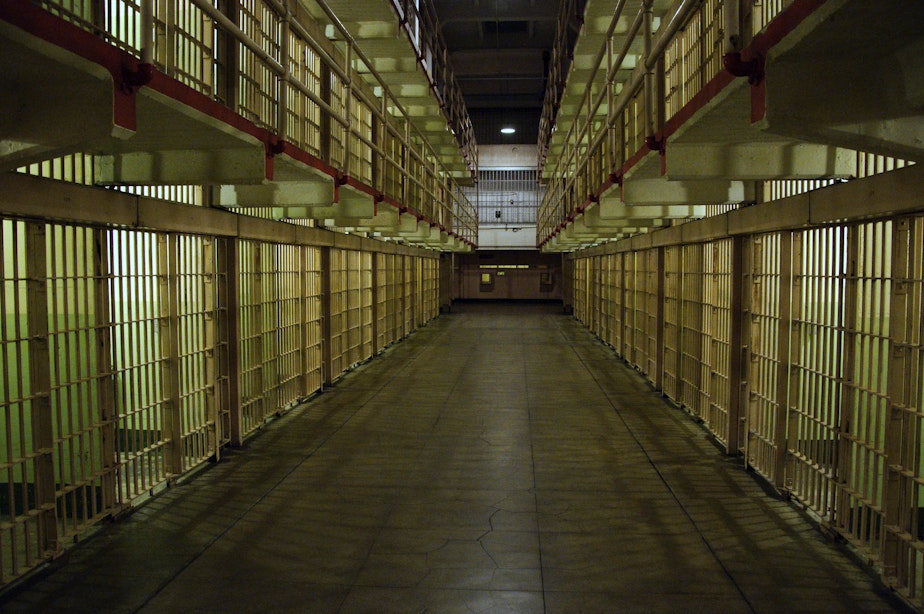Washington Supreme Court denies inmates' Covid-19 petition

Using their web cameras, and calling in from separate locations, the Washington State Supreme Court Justices and lawyers met over a Zoom call Thursday morning.
Justices listened in as lawyers made their case on both sides of a lawsuit that seeks the release of thousands of Washington state inmates, prompted by the coronavirus pandemic.
By the afternoon, the court had denied the petition to release additional inmates in fear of contracting Covid-19.
The justices wrote that the petitioners failed to show how the state was failing to perform “a mandatory, nondiscretionary duty in addressing the Covid-19 risk at the Department of Corrections facilities, nor shown other constitutional or statutory grounds for the relief they request."
Washington Supreme Court Order 98317-8
The lawsuit, filed by Columbia Legal Services on the behalf of inmate petitioners, argues that it’s unconstitutional for the state to hold people in prisons without adequate sanitizing practices and the space needed for social-distancing.
Thirteen inmates at state prisons have contracted the coronavirus so far, all of which are housed at the Monroe Correctional Complex, according to numbers collected by the Department of Corrections.
Sponsored
Gov. Jay Inslee, in collaboration with Department of Correction Secretary Stephen Sinclair, has already made moves to release more than 1,100 non-violent and vulnerable inmates in Washington state.
In the coming week, the state’s prison population will drop below 16,000, said John Samson, an assistant state attorney general. Samson, who represents lawsuit respondents Gov. Inslee and Sinclair, said prior to these releases, the population was at 17,700.
But Columbia Legal Services attorney Nick Straley said the Department of Corrections must illustrate how this reduced population allows for adequate social distancing.
“What they haven't done is haven't demonstrated that social distancing is possible in every prison in Washington, and in fact all of the evidence before the court suggests it's not,” Straley said.
Samson, who represents Inslee, said it was the state’s position that the planned inmate releases was enough, based on Centers for Disease Control and Prevention guidelines and on the chief medical officer’s evaluation.
Sponsored
“Those have certainly made a difference, but we've all seen the ombuds report and the photographs there. How does what you're saying square with the pictures of people, one on top of another at Monroe?" asked Justice Sheryl Gordon McCloud.
On April 10, the Office of the Corrections Ombuds paid a visit to the Monroe Correctional Complex, just two days after inmates protested the conditions there.
Photos captured that day show inmates crowded in hallways and while making phone calls. Other inmates in isolation for Covid-19 reported during the visit that showering was limited to once per week. The report repeatedly noted the rising tension felt by both inmates and staff, stressed over the spread of coronavirus.
In the E Unit, there were reports of freezing temperatures and cold, brown undrinkable water. While the temperature had improved by the time the report was drafted, the brown water remained. One inmate said use of the sink would cause his entire cell to flood. Linens were on the floor around the toilet, in an attempt to soak up the water.
But the biggest concern for inmates, according to the report, was a lack of access to telephones, to contact loved ones who were worried for their safety.
Sponsored
Samson said the ombuds report was weeks old, and prior to any reductions in prison population. He said that by this coming weekend, the minimum security unit of the Monroe Complex would be able to guarantee 6 feet of social distancing.
“Even when the department provides the space, it's still going to be up to the individuals in that institution to exercise social distancing in the same way that we have to when we go to the grocery store, and there's more than two people in an aisle,” Samson said.
However, he said he could not guarantee that every single prison cell would provide 6 feet of sleeping distance. That's not constitutionally required, he said.
The day before the Thursday hearings, supporters of the lawsuit stood outside the state Supreme Court in Olympia holding signs with the messages "Free our loved ones" and "Minimum security releases = low threat."
The next day, those against Inslee's preemptive inmate release also traveled to Olympia. Seattle Police Officers Guild President Mike Solan, joined with crime victims, voiced opposition to the 1,167 inmates being released from Washington State’s Department of Corrections.
Sponsored
The lawsuit targets the release of inmates over the age of 50, and those with identified medical problems, but Straley said the petitioner’s position isn’t that everyone that falls in those categories should be released. He agreed that there would be situations where someone shouldn’t be released, but many inmates who should.
“There are 300 to 400 people who don't have a victim notification requirement that are within 18 months of their release,” he said. “I would submit that a lot of those people can be released without much examination at all.”
Justices pointed out that for many inmates, quick early release could mean inmates would be left with no supports in place, and with no home to go to. Straley said although that is true, the state could make quick steps to decipher which inmates would have a home to return to.
He added that more has to be done on the release side, and on the support side for survivors, and that the state must locate the resources to live up to its constitutional obligations for both parties.

